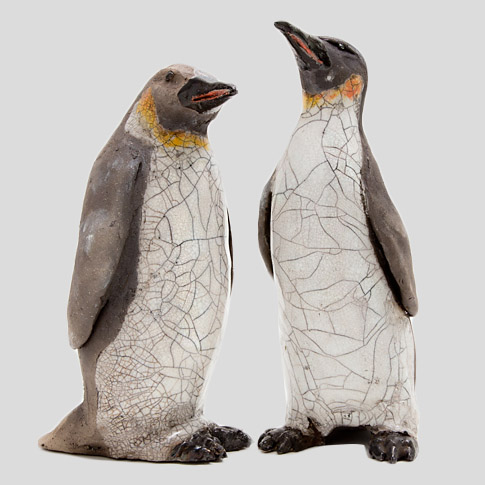Obvara Firing is an Eastern European technique. The bisque fired pots are fired in a Raku kiln. As they are removed they are dipped in mixture of flour, yeast, sugar and water and then plunged in to water to stop the changes. The longer the pot stays in the flour mixture, the darker the effect. It is a rapid process, so literally seconds in the mixture makes the changes.

The pots work well if they are burnished at the leatherhard stage. They also work well with texture on the outside as the colours of the technique really highlight the marks.
The recipe ( if you can call it that) is: 2.2 lb of flour/ 1-2 packets of yeast/ 1tbsp sugar/ 2.6 gallons of water. Mix together 2-3 days before use to allow to ferment.
Warning: it is quite smelly and if you are transporting the mixture put the pot in a plastic bag to protect the car! If you look up Baltic Raku or Obvara Raku on the internet you will find videos and other examples of the firing technique.


Hello, I would appreciate resolving a problem I had when I did all the process of the Obvara firing. No problem, the pieces came out outstanding! I washed them, as I had done the previous firing, but this time. after the washing…… they all faded, almost completely!!!
What, do you think happened?
I would most certainly appreciate your comments!!
Thanks, hope to hear from you…. I love this firing and
I really don’t understand what happened or I failed this time. Thanks again.
Hi Rose Marie,
Sorry for the long delay in replying., from your date. This has only recently appeared on my site.
When you wash the pieces afterwards are you scrubbing them or just washing off the residue of the obvara mix?
I can only imagine that perhaps the temperature you are putting them in the mix is not quite right.
If they are too hot then the mix may just burn away, too cool and the mix won’t carbonise on to the clay.
We fire to about 1000 degrees C, but allow the pieces to be put in Obvara to cool a little. I have certainly noticed that if they have cooled too much, the colour is much less strong and doesn’t really work.
I hope that helps,
Carol
Can you reuse the mixture ?
Hi Lily, It lasts a few days, even a week, but eventually the reaction stops. I have rejuvenated a mixture by adding a tub of live culture yoghurt.
Good luck.
Carol
Can obavara bowls be used for food? If not, why?
Hi Obvara technique does give pottery a sort of seal. The pots will remain porous, however, as they are not high fired. The Obvara mix is non toxic- just flour, yeast, sugar and water. Try it cautiously and be aware that the pot won’t be completely watertight.
After mixing, does the mixture need to be kept at a certain temperature, until using it days later? At night, my studio is about 43F.
Thanks!
It suggests keeping it warm, but we have kept it outside. The effect only lasts a few days after the fermentation time. It needs to be remade fresh if you are no longer getting the reaction.
Hello, I made lovely Obvara goblet bottoms…….I cut off the top of the glass wine glasses and then insert stem and glue into the Obvara bottoms.
They are lovely, after I used them last night I rinsed the glass…….of course, however, the obvara bottom got wet and a little sticky/slick. I turned them upside down and they dryed beautifully and were perfect to hold when they were dry. Question does this always happen when wet? My problem, I was going to sell them……..if they are OK, and I think they are……what do I tell customers? They are beautiful!! Thanks, Tina Oxer
Hi Tina
The stickiness comes from the yeast mixture. I have no idea how they would stand up to regular washing as the clay stays porous. I would test them out yourself over a period of time before selling.
Carol